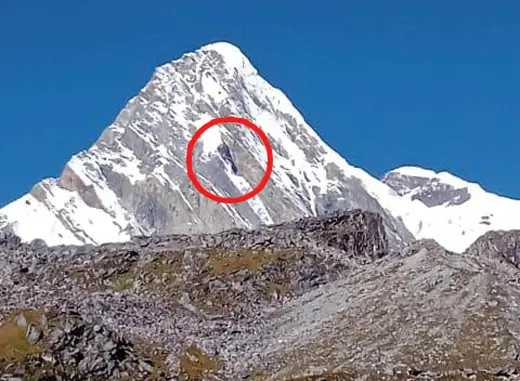[ Pai Dawe ]
The unfortunate report of Everester Tapi Mra and his companion Niku Dao going missing during their expedition to Khayarii Satam peak brings back the sacred mountain under the spotlight.
Whether one believes it or not, we tribal people are so driven by nature that we have tales for every mountain, river, gorge, animal and bird. Sometimes it may sound superstitious, but some are absolutely sacred and require certain traditional ways of appeasing and seeking permission by performing rituals before venturing into their domains.
Khayarii Satam is one such sacred mountain, named after Abang Khayarii (brother Khayarii) and Satam (his shield armour, which is made of dried sebi (serow) skin. It is believed that, according to his last wishes, his mortal remains were kept in this mountain, so that no living being reaches him.
Located northwest of East Kameng district, the golden spectacle of the Himalayas at dawn from Chayang Tajo and Lada is mesmerising. One can see the legendary Abang Khyarii Sattam or the shield/armour of brother Kyarii, which is indeed a black rock face where snow hardly settles throughout the year.
Abang Khyarii had two wives, the first being Changam Rewene and the second being Changam Rowone. Abang Khyarii was a great warrior and an expert hunter. He hunted various kinds of wild animals for the family. But Changam Rewene was never happy about it, claiming that they were her parent’s (Ato Nyidi) pets. Abang Khyarii was annoyed by her response and enquired for the reason behind it.
Changam Rewene put a condition that if he could kill the Punghi ne selangwo ga Firam Talang bo (wild boar) and Punghi ne Selewo ga Rale Yapene (giant fish), then she would be happy.
Abang Khyarii agreed to the conditions, and informed her that if Sedam lo- Dogam (thunders) are heard from the north side, then assume that Firam Talang bo has been killed, and if Swko lo-Dorah (sparks) are seen from the south, then assume that Rale Yapene has been killed.
After some time, a thunderous sound with storms was heard from the north side. Changam Rewene knew that Firam Talang bo was killed, and indeed Abang Khyarii had killed Firam Tallang bo, but while he was carrying it with joyik (rope made from a plant), it slipped and fell down, causing serious injury to Khyarii’s leg with the canine teeth of the wild boar.
Even after 10 days passed, Abang Khyarii didn’t reach home. Everybody was worried, but after 10 days he reached home with serious injuries.
Changam Rewene advised him to apply dodo nyerik and sangffa (leaves of wild elephant ears or Colocasia esculenta) and the bark of Schima wallichi tree as medicine, but Changam Rowone advised him to apply bichang billang and moro killo (natural herbs/medicinal plant).
Abang Khyarii trusted the first wife more and applied the cure according to her advice. It aggravated his injury and Abang Khyarii died after some days. But before he died, he made the last wish that his dead body shouldn’t be buried in pane narthe (low land) but taken to the highest peak of the mountain where no animal and human being exists and can reach. Accordingly, his mortal remains were taken to the highest peak of the mountain – the great Kra Dadi – with all his armours, including Khyarii Sattam.
The Sattam signifies the symbol of power and pride derived from Abang Khyasang Uglang and Tadu Uglang. This is the reason why Khyarii Sattam is prominently visible throughout the year, signifying the pride and dignity of Abang Khyarii.
With the rescue operation in place, the East Kameng district administration and the EKSWCO may also perform rituals for retrieving them. My heartfelt prayers for the early retrieval of both Tapi Mra and Niku Dao. Atur to Ane Donyi. (The writer is president, NNMR)



